领B学习规划 小新星
小新星英语学习计划
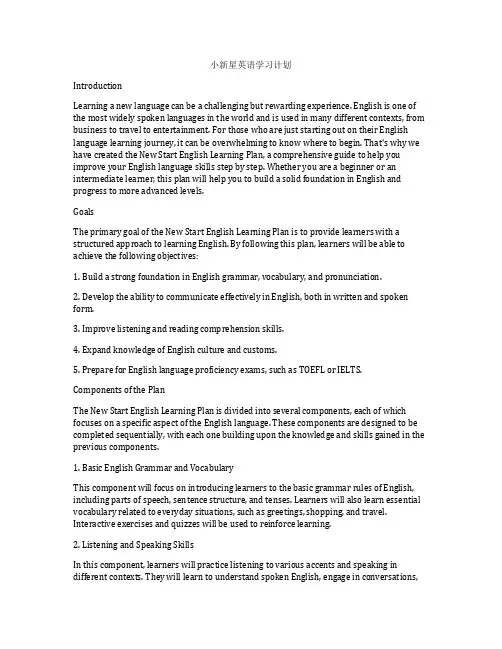
小新星英语学习计划IntroductionLearning a new language can be a challenging but rewarding experience. English is one of the most widely spoken languages in the world and is used in many different contexts, from business to travel to entertainment. For those who are just starting out on their English language learning journey, it can be overwhelming to know where to begin. That's why we have created the New Start English Learning Plan, a comprehensive guide to help you improve your English language skills step by step. Whether you are a beginner or an intermediate learner, this plan will help you to build a solid foundation in English and progress to more advanced levels.GoalsThe primary goal of the New Start English Learning Plan is to provide learners with a structured approach to learning English. By following this plan, learners will be able to achieve the following objectives:1. Build a strong foundation in English grammar, vocabulary, and pronunciation.2. Develop the ability to communicate effectively in English, both in written and spoken form.3. Improve listening and reading comprehension skills.4. Expand knowledge of English culture and customs.5. Prepare for English language proficiency exams, such as TOEFL or IELTS. Components of the PlanThe New Start English Learning Plan is divided into several components, each of which focuses on a specific aspect of the English language. These components are designed to be completed sequentially, with each one building upon the knowledge and skills gained in the previous components.1. Basic English Grammar and VocabularyThis component will focus on introducing learners to the basic grammar rules of English, including parts of speech, sentence structure, and tenses. Learners will also learn essential vocabulary related to everyday situations, such as greetings, shopping, and travel. Interactive exercises and quizzes will be used to reinforce learning.2. Listening and Speaking SkillsIn this component, learners will practice listening to various accents and speaking in different contexts. They will learn to understand spoken English, engage in conversations,and give presentations. Through role-plays and group discussions, learners will gain confidence in their speaking abilities.3. Reading ComprehensionLearners will work on reading a variety of texts, such as articles, stories, and academic papers. They will learn how to extract important information from the texts, infer meaning, and make inferences. Reading exercises will be followed by discussions and written assignments to ensure comprehension.4. Writing SkillsThis component will focus on developing writing skills, including sentence and paragraph structure, grammar, punctuation, and vocabulary. Learners will practice writing different types of texts, such as emails, essays, and reports, and receive feedback from instructors.5. Cultural UnderstandingTo better understand the English language and its usage, learners will delve into the culture, customs, and traditions of English-speaking countries. This will help them to develop a deeper understanding of the language and its context.6. Test PreparationFor those who are preparing for English language proficiency exams, this component will provide guidance on exam format, strategies, and practice tests. Learners will be given tips on how to approach multiple-choice questions, essay writing, and speaking tasks. ScheduleThe New Start English Learning Plan is designed to be completed over a period of six months, with learners devoting approximately 10-15 hours per week to their studies. The following is a sample schedule for completing the plan:Month 1-2: Basic English Grammar and VocabularyMonths 3-4: Listening and Speaking SkillsMonths 5-6: Reading Comprehension, Writing Skills, Cultural Understanding, and Test PreparationUpon completion of the plan, learners should have a strong foundation in English and be ready to take their language skills to the next level.ResourcesIn addition to the structured components of the New Start English Learning Plan, learners will have access to a variety of resources to support their studies. These resources include:- Online learning platform with interactive lessons and exercises- Audio and video materials for listening and speaking practice- Reading materials, such as books, articles, and websites- Writing prompts and assignments- Cultural resources, such as films, music, and documentaries- Practice tests for English language proficiency examsInstructorsLearners will be guided by experienced and qualified instructors who are dedicated to helping them achieve their language learning goals. Instructors will provide regular feedback on assignments, offer support and guidance, and track learners' progress throughout the program.ConclusionThe New Start English Learning Plan is a comprehensive and structured approach to learning English. Whether you are a beginner or an intermediate learner, this plan will provide you with the tools and resources you need to build a solid foundation in English and progress to more advanced levels. By following this plan, you will not only improve your language skills but also gain a deeper understanding of English language and culture. So, if you are ready to take your English language learning to the next level, the New Start English Learning Plan is here to guide you every step of the way. Good luck!。
为什么要选择小新星
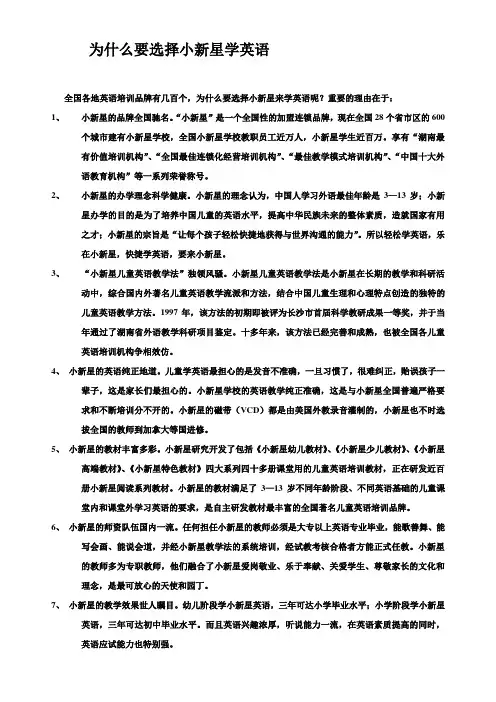
为什么要选择小新星学英语全国各地英语培训品牌有几百个,为什么要选择小新星来学英语呢?重要的理由在于:1、小新星的品牌全国驰名。
“小新星”是一个全国性的加盟连锁品牌,现在全国28个省市区的600个城市建有小新星学校,全国小新星学校教职员工近万人,小新星学生近百万。
享有“湖南最有价值培训机构”、“全国最佳连锁化经营培训机构”、“最佳教学模式培训机构”、“中国十大外语教育机构”等一系列荣誉称号。
2、小新星的办学理念科学健康。
小新星的理念认为,中国人学习外语最佳年龄是3—13岁;小新星办学的目的是为了培养中国儿童的英语水平,提高中华民族未来的整体素质,造就国家有用之才;小新星的宗旨是“让每个孩子轻松快捷地获得与世界沟通的能力”。
所以轻松学英语,乐在小新星,快捷学英语,要来小新星。
3、“小新星儿童英语教学法”独领风骚。
小新星儿童英语教学法是小新星在长期的教学和科研活动中,综合国内外著名儿童英语教学流派和方法,结合中国儿童生理和心理特点创造的独特的儿童英语教学方法。
1997年,该方法的初期即被评为长沙市首届科学教研成果一等奖,并于当年通过了湖南省外语教学科研项目鉴定。
十多年来,该方法已经完善和成熟,也被全国各儿童英语培训机构争相效仿。
4、小新星的英语纯正地道。
儿童学英语最担心的是发音不准确,一旦习惯了,很难纠正,贻误孩子一辈子,这是家长们最担心的。
小新星学校的英语教学纯正准确,这是与小新星全国普遍严格要求和不断培训分不开的。
小新星的磁带(VCD)都是由美国外教录音灌制的,小新星也不时选拔全国的教师到加拿大等国进修。
5、小新星的教材丰富多彩。
小新星研究开发了包括《小新星幼儿教材》、《小新星少儿教材》、《小新星高端教材》、《小新星特色教材》四大系列四十多册课堂用的儿童英语培训教材,正在研发近百册小新星阅读系列教材。
小新星的教材满足了3—13岁不同年龄阶段、不同英语基础的儿童课堂内和课堂外学习英语的要求,是自主研发教材最丰富的全国著名儿童英语培训品牌。
步步培优英语学习计划小学

步步培优英语学习计划小学第一步:明确学习目标在开始学习英语之前,我们需要明确学习目标。
例如,是想要提高听说能力,还是想要加强阅读写作能力。
根据不同的学习目标,我们可以制定出不同的学习计划。
第二步:制定学习计划1.每天坚持学习一定时间英语学习需要坚持不懈,每天都要花一定的时间来学习。
可以将学习时间安排在每天的早晨或者晚上,这样能够保证学习的连贯性和坚持性。
2.选择合适的学习材料根据自己的学习目标,选择合适的学习材料,例如英语教材、英语绘本、英语视频等。
3.制定每月学习计划每个月可以制定一个学习计划,列出当月要学习的内容和目标,然后按照计划进行学习。
第三步:学习方法1.听力练习可以通过听英语歌曲、英语广播、英语电影等来练习听力。
还可以下载一些英语听力材料,例如BBC Learning English,VOA Learning English等。
2.口语练习对于口语练习,可以找一些语伴练习口语,也可以通过模仿英语对话来提高口语能力。
3.阅读练习可以通过阅读绘本、英语故事书、英语杂志等来提高阅读能力。
4.写作练习练习写作可以通过每天写日记或者写英语作文来提高写作能力。
第四步:学习环境创造良好的学习环境对于英语学习很重要。
可以选择一个安静的地方,保持良好的学习氛围。
另外,可以选择一些适合学习英语的背景音乐或者白噪音来帮助学习。
第五步:监督和改进在学习过程中,要不断地进行监督和改进。
可以通过定期的测验来检测学习效果,并根据检测结果来进行调整学习计划。
另外,可以找一些英语学习群或者社交平台,与其他学习者交流,互相监督和帮助。
第六步:培养兴趣英语学习是一个长期的过程,要坚持学习,就需要培养兴趣。
可以通过英语歌曲、英语电影、英语游戏等来增加对英语的兴趣,从而更有动力地学习。
总结:英语学习需要坚持不懈,要制定合理的学习计划,并在学习过程中不断地进行监督和改进。
同时,培养对英语的兴趣,可以更好地坚持下去。
希望大家都能够通过自己的努力,成为优秀的英语学习者。
小星星英语学习计划小学
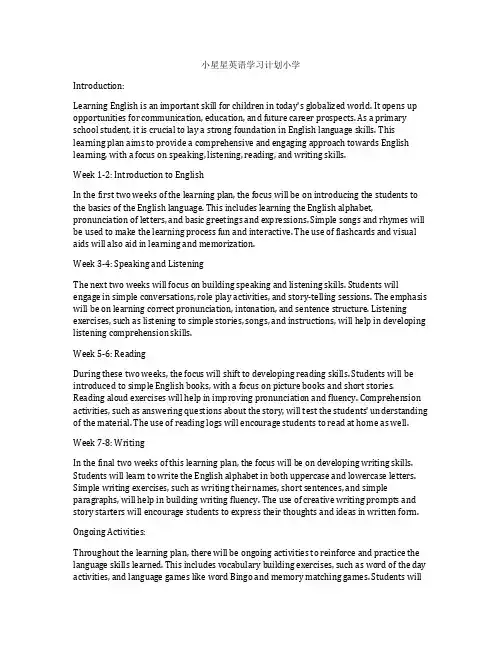
小星星英语学习计划小学Introduction:Learning English is an important skill for children in today's globalized world. It opens up opportunities for communication, education, and future career prospects. As a primary school student, it is crucial to lay a strong foundation in English language skills. This learning plan aims to provide a comprehensive and engaging approach towards English learning, with a focus on speaking, listening, reading, and writing skills.Week 1-2: Introduction to EnglishIn the first two weeks of the learning plan, the focus will be on introducing the students to the basics of the English language. This includes learning the English alphabet, pronunciation of letters, and basic greetings and expressions. Simple songs and rhymes will be used to make the learning process fun and interactive. The use of flashcards and visual aids will also aid in learning and memorization.Week 3-4: Speaking and ListeningThe next two weeks will focus on building speaking and listening skills. Students will engage in simple conversations, role play activities, and story-telling sessions. The emphasis will be on learning correct pronunciation, intonation, and sentence structure. Listening exercises, such as listening to simple stories, songs, and instructions, will help in developing listening comprehension skills.Week 5-6: ReadingDuring these two weeks, the focus will shift to developing reading skills. Students will be introduced to simple English books, with a focus on picture books and short stories. Reading aloud exercises will help in improving pronunciation and fluency. Comprehension activities, such as answering questions about the story, will test the students' understanding of the material. The use of reading logs will encourage students to read at home as well.Week 7-8: WritingIn the final two weeks of this learning plan, the focus will be on developing writing skills. Students will learn to write the English alphabet in both uppercase and lowercase letters. Simple writing exercises, such as writing their names, short sentences, and simple paragraphs, will help in building writing fluency. The use of creative writing prompts and story starters will encourage students to express their thoughts and ideas in written form. Ongoing Activities:Throughout the learning plan, there will be ongoing activities to reinforce and practice the language skills learned. This includes vocabulary building exercises, such as word of the day activities, and language games like word Bingo and memory matching games. Students willalso be encouraged to engage in English language activities outside the classroom, such as listening to English songs, watching English cartoons, and practicing English conversations with their peers.Assessment:At the end of the learning plan, there will be a comprehensive assessment to evaluate the students' language proficiency. This will include a speaking assessment, a reading comprehension test, and a writing assignment. The assessment will provide valuable feedback on the students' progress and identify areas for further improvement.Conclusion:This Starry English Learning Plan aims to lay a solid foundation for English language learning in primary school students. By providing a comprehensive and engaging approach towards language acquisition, students will be equipped with the necessary skills to communicate effectively in English. Through the use of interactive and fun activities, students will develop a love for learning English, setting the stage for future language acquisition and fluency.。
小星星英语学习计划大学
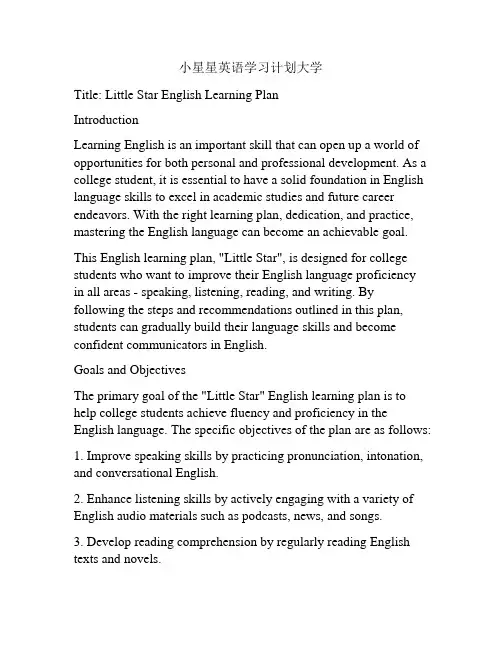
小星星英语学习计划大学Title: Little Star English Learning PlanIntroductionLearning English is an important skill that can open up a world of opportunities for both personal and professional development. As a college student, it is essential to have a solid foundation in English language skills to excel in academic studies and future career endeavors. With the right learning plan, dedication, and practice, mastering the English language can become an achievable goal.This English learning plan, "Little Star", is designed for college students who want to improve their English language proficiencyin all areas - speaking, listening, reading, and writing. By following the steps and recommendations outlined in this plan, students can gradually build their language skills and become confident communicators in English.Goals and ObjectivesThe primary goal of the "Little Star" English learning plan is to help college students achieve fluency and proficiency in the English language. The specific objectives of the plan are as follows:1. Improve speaking skills by practicing pronunciation, intonation, and conversational English.2. Enhance listening skills by actively engaging with a variety of English audio materials such as podcasts, news, and songs.3. Develop reading comprehension by regularly reading English texts and novels.4. Expand vocabulary and grammar knowledge through systematic study and practice.5. Strengthen writing skills by regularly writing essays, reports, and creative pieces in English.The "Little Star" English learning plan is designed to be a comprehensive and well-rounded approach to language learning. The plan is flexible and can be tailored to each individual's needs and learning pace.Weekly Study PlanWeek 1-2: Speaking and Pronunciation- Practice pronunciation of common English sounds and phonemes. - Listen to English speakers and imitate their intonation and rhythm.- Engage in daily English conversations with classmates or language exchange partners.Week 3-4: Listening Skills- Listen to English podcasts, news, and radio shows to improve listening comprehension.- Watch English films with subtitles to practice listening and understanding spoken English.- Take note of unfamiliar words or expressions and look them up in a dictionary.Week 5-6: Reading Comprehension- Read English texts, articles, and short stories to develop reading skills.- Summarize the main ideas and key points of the texts to improve comprehension.- Discuss the content of the readings with peers or instructors to enhance understanding.Week 7-8: Vocabulary and Grammar- Learn new English words and phrases every day and practice using them in sentences.- Review common grammatical structures and rules through grammar exercises and drills.- Use flashcards or online resources to expand and reinforce vocabulary knowledge.Week 9-10: Writing Skills- Write short essays or journal entries in English to practice expressing thoughts and ideas.- Seek feedback from teachers or language partners to improve writing skills.- Edit and revise written work to enhance clarity, coherence, and overall quality.Monthly Study PlanMonth 1: Speaking and Listening- Participate in English conversation groups or clubs to practice speaking and listening skills.- Watch English news broadcasts or listen to English radio programs to expose oneself to different accents and speech patterns. Month 2: Reading and Vocabulary- Read English novels, newspapers, or magazines regularly to build reading comprehension skills.- Learn new vocabulary through reading and keep a vocabulary journal to track progress and review.Month 3: Grammar and Writing- Focus on improving grammar accuracy and complexity in written assignments.- Write longer essays and reports to practice organizing thoughts and arguments in English.Additional ResourcesTo supplement the "Little Star" English learning plan, students can also utilize additional resources and tools to enhance their language skills. These may include:- Language learning apps and websites such as Duolingo, Rosetta Stone, and Memrise for vocabulary and grammar practice.- Online language exchange platforms to connect with native English speakers for conversational practice.- English language courses and workshops offered by college language centers or online education platforms.- Language learning communities and forums for sharing experiences, tips, and resources with other English learners.ConclusionMastering the English language is a valuable asset for college students in their academic and professional pursuits. The "Little Star" English learning plan provides a structured and comprehensive approach to language learning, covering all aspects of language skills - speaking, listening, reading, and writing. By following the plan and incorporating additional resources, students can progress steadily towards fluency and proficiency in English, opening up a world of opportunities for personal and professional growth. With dedication and practice, the goal of becoming a confident communicator in English can be achieved.。
abcreading怎么制定学习计划
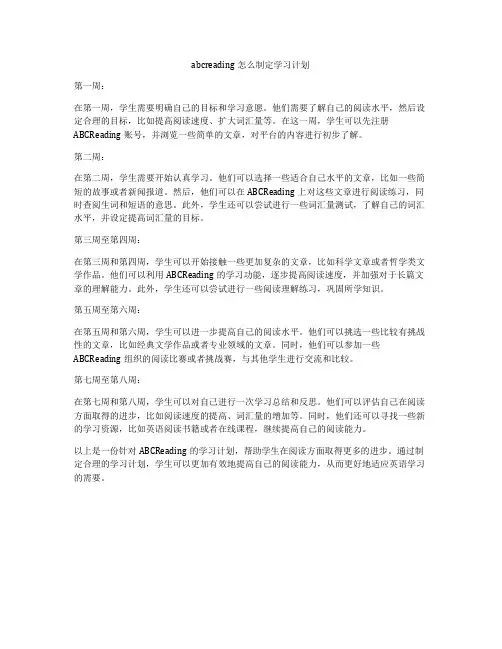
abcreading怎么制定学习计划第一周:在第一周,学生需要明确自己的目标和学习意愿。
他们需要了解自己的阅读水平,然后设定合理的目标,比如提高阅读速度、扩大词汇量等。
在这一周,学生可以先注册ABCReading账号,并浏览一些简单的文章,对平台的内容进行初步了解。
第二周:在第二周,学生需要开始认真学习。
他们可以选择一些适合自己水平的文章,比如一些简短的故事或者新闻报道。
然后,他们可以在ABCReading上对这些文章进行阅读练习,同时查阅生词和短语的意思。
此外,学生还可以尝试进行一些词汇量测试,了解自己的词汇水平,并设定提高词汇量的目标。
第三周至第四周:在第三周和第四周,学生可以开始接触一些更加复杂的文章,比如科学文章或者哲学类文学作品。
他们可以利用ABCReading的学习功能,逐步提高阅读速度,并加强对于长篇文章的理解能力。
此外,学生还可以尝试进行一些阅读理解练习,巩固所学知识。
第五周至第六周:在第五周和第六周,学生可以进一步提高自己的阅读水平。
他们可以挑选一些比较有挑战性的文章,比如经典文学作品或者专业领域的文章。
同时,他们可以参加一些ABCReading组织的阅读比赛或者挑战赛,与其他学生进行交流和比较。
第七周至第八周:在第七周和第八周,学生可以对自己进行一次学习总结和反思。
他们可以评估自己在阅读方面取得的进步,比如阅读速度的提高、词汇量的增加等。
同时,他们还可以寻找一些新的学习资源,比如英语阅读书籍或者在线课程,继续提高自己的阅读能力。
以上是一份针对ABCReading的学习计划,帮助学生在阅读方面取得更多的进步。
通过制定合理的学习计划,学生可以更加有效地提高自己的阅读能力,从而更好地适应英语学习的需要。
小新星英语学校美式音标班教学计划
小新星英语学校美式音标班教学计划为了更好地提高小朋友们的语音水平,小新星英语学校利用国庆节的前5天的时间举办这次纯正美式音标的学习.在学习的过程当中:老师要以最轻松,最有趣和最有效的方法把语音知识与小朋友们一起来分享.我们的课堂将是生动的,诙谐的,会让学生在玩耍和乐趣中牢固地掌握好所学的东西。
具体教学计划如下:整个教学计划中大致分为四个板块:第一板块:音标和范例对应练习第二板块:词汇游戏和对应练习第三板块:英文歌曲学习第四板块:小老师巩固练习第一板块至第二板块:在这一板块中,主要分为元音和辅音的结合练习,一般安排在每一次课的前三十分钟,接着让学生在和老师游戏的互动中进行大规模的操练。
游戏大致上分为Magic fingers,High and low voice,Fast reaction等一系列小新星教学中出现较多的常规游戏,也会根据学生的年龄适当的编制一些颇具挑战性的游戏,让课堂的气氛活跃的同时,更能使学生驾轻就熟地掌握好所学的知识。
接下来便是第三板块--英文歌曲学习。
在每次课的第二课时的开始,会适当地教一些不具备太大难度且节奏欢快明朗的英文歌曲,这样可以起到缓解上节课学习压力的作用,也可以寓教于乐。
另外英文歌曲的聆听对于学生的音标掌握也是很有帮助的,这些歌曲都是美国小朋友所演唱,对教学颇具作用,相信学生们也会喜欢的。
英文歌曲时间大致上定为一刻钟左右,然后然后进入到第四板块--小老师巩固练习:请两到三位小老师上讲台来一起回顾上节课的内容,这样会增强小朋友的成就感,对于巩固这次课所学到的?在整个教学过程中,老师会依据学生在学习过程中的表现给予适当的奖励。
具体教学流程如下:第一天:元音的前六个音标囊括的单词有:bee eat big six bed egg add bag box dog door floor第一天所包括的歌曲是:NUMBER SONG歌词:one two three four five six seven,eight nine ten next is eleventwelve thirteen fourteen fifteen,sixteen seventeen,eighteen ninteen twenty.I can count to the number twenty,I can count to the number twenty.Learning to count is fun and easy,won't you sing with me 在教学的过程中,贯穿小新星的传统游戏magic fingers,high and low voice,sharp ears等。
小星星英语学习计划初中
小星星英语学习计划初中I. IntroductionLearning English has become crucial for individuals who seek to succeed in today's globalized world. As a middle school student, it is important to establish a solid foundation in English to enhance one's reading, writing, listening, and communication skills. This learning plan is designed to provide a structured approach to improving English proficiency and achieving academic success.II. Goals1. Develop a strong grasp of grammar and vocabulary.2. Improve reading comprehension and critical thinking skills.3. Enhance writing proficiency and creativity.4. Build confidence in speaking and listening to English.III. Study ScheduleMonday to Friday:- 30 minutes of grammar and vocabulary exercises.- 30 minutes of reading and comprehension practice.- 30 minutes of writing assignments.- 30 minutes of listening and speaking activities.Saturday and Sunday:- Review the week's lessons and complete any unfinished assignments.- Engage in language immersion activities such as watching English movies, reading English books, or listening to English podcasts.IV. Grammar and VocabularyTo develop a strong grasp of grammar and vocabulary, students will engage in regular practice exercises. This includes learning about verb tenses, sentence structure, parts of speech, and common idiomatic expressions. Additionally, students will be encouraged to expand their vocabulary through word lists, flashcards, and contextual learning. Regular quizzes and exercises will be administered to reinforce these concepts.V. Reading and ComprehensionReading comprehension is a crucial skill that contributes to overall academic success. Students will be provided with a variety of reading materials including short stories, articles, and non-fiction texts. Each week, students will be assigned reading passages followed by comprehension questions and critical thinking exercises. This helps students to develop their analytical skills and understanding of different writing styles.VI. Writing AssignmentsWriting proficiency is key to effective communication. Students will be tasked with various writing assignments such as essays, creative writing prompts, and letter writing exercises. Emphasis will be placed on developing coherent and cohesive writing, proper grammar usage, and attention to detail. Additionally, students will receive constructive feedback on their writing, enabling them to improve their skills over time.VII. Listening and SpeakingOral communication is a vital aspect of language learning. To improve listening and speaking skills, students will engage in activities such as listening to audio recordings, participating in group discussions, and delivering presentations. This will help students become more confident in their ability to understand spoken English and communicate effectively in various settings.VIII. Resources and SupportStudents will be provided with a range of resources to support their English learning journey. This includes access to online learning platforms, English language apps, and reference materials. Additionally, students will have the opportunity to seek guidance and support from their teachers, who will be available to provide assistance and answer any questions that arise during the learning process.IX. Evaluation and Progress TrackingRegular assessments will be conducted to evaluate students' progress and identify areas for improvement. This will include quizzes, tests, and performance evaluations on grammar, vocabulary, reading comprehension, writing, and speaking skills. Students will also be encouraged to maintain a portfolio of their work to track their progress and reflect on their learning journey.X. ConclusionBy following this structured English learning plan, middle school students can develop a strong foundation in English language skills. The goal is to equip students with the tools and confidence to communicate effectively, understand complex texts, and excel academically. With dedication and consistent practice, students will be well-prepared to tackle the challenges of learning English and achieve success in their academic endeavors.。
实习生实习计划作文
实习生实习计划作文实习生活就要开始啦,就像一场未知的冒险之旅,我可得好好规划规划。
一、实习目标。
1. 技能提升。
我就像一块干巴巴的海绵,到这个公司来就是想拼命吸水的。
首要目标就是熟练掌握岗位相关的专业技能。
比如说,我要是在文案编辑岗位,那我希望自己能熟练使用各种文案排版工具,像个小魔法师一样把文字变得又好看又吸引人。
要是在设计岗位,我得把那些设计软件玩得溜溜转,做出超级酷炫的图。
2. 职场融入。
这公司就像一个小社会,我得努力变成其中的一员。
学会怎么跟同事打交道,那些职场上的暗语和小规则我也得搞明白。
我可不想总是当那个懵懵懂懂的小菜鸟,要成为能跟大家愉快聊天、一起合作的小伙伴。
3. 确定职业方向。
现在我就像在大雾里走路,虽然知道大方向,但是还不太确定自己到底适合干啥。
通过实习,我想清楚自己是不是真的喜欢这个行业、这个岗位。
要是不合适,就像试错一样,赶紧调整方向,可别在一棵树上吊死。
二、实习内容与安排。
1. 第一周:适应期。
第一天到第三天。
熟悉公司环境。
我就像个小探险家一样,到处走走看看。
找到食堂在哪,这样就不会饿肚子啦;知道茶水间在哪,渴了能随时补充水分;还有最重要的,搞清楚卫生间的位置,这可是很紧急的事儿呢。
认识同事。
我会带着我最灿烂的笑容,主动跟大家打招呼,自我介绍的时候尽量说得有趣一点,让大家一下子就能记住我。
比如说,“嗨,我是[名字],我来这儿实习就像超级马里奥进了新的城堡,希望和大家一起愉快闯关。
”第四天到第五天。
了解公司的规章制度。
那些厚厚的文件看起来有点吓人,但我会像看小说一样认真对待。
可不能一不小心就踩了红线,我还想在这儿好好表现呢。
学习岗位的基础工作流程。
跟着带我的师傅后面,像个小尾巴一样,看他怎么做,然后拿个小本子偷偷记下来,回家再复习复习。
2. 第二周第四周:学习期。
第二周。
开始接手一些简单的任务。
比如说整理文件、做一些基础的数据录入。
虽然这些活儿看起来简单,但是我也会做得一丝不苟,就像在雕琢一件艺术品一样。
6岁英语raz学习计划
6岁英语raz学习计划第一阶段:建立基础在孩子6岁的时候,他们正处于对各种学科充满好奇心和求知欲的年龄。
在英语学习领域,我们需要建立孩子的基础,让他们对英语产生兴趣,培养他们的语言能力和表达能力。
1. 每天阅读阅读对于孩子的英语学习至关重要。
我们会每天给孩子准备一本适合他们年龄的英语绘本或故事书,让他们在家里或者学校有指导老师的陪伴下阅读,鼓励孩子自己尝试读出书中的文字,同时教导他们正确的发音和语调。
通过阅读,孩子可以提高自己的词汇量,培养语感和表达能力。
2. 游戏学习我们将引导孩子通过一些英语游戏来学习,比如用英语进行角色扮演游戏,或者在游戏中学习英语歌曲和英语单词。
通过游戏,孩子可以在愉快的氛围中学习英语,树立自信,培养学习兴趣。
3. 歌曲和音乐孩子们喜欢听音乐和唱歌,我们可以通过英语歌曲来帮助他们学习英语。
每周会安排一次唱歌比赛或者表演,让孩子们在音乐中学习英语,同时提高他们的英语口语表达能力。
第二阶段:扩展知识一旦孩子建立了基础,我们将引导他们开始扩展英语知识,学习更多的词汇和语法知识,提高他们的听说读写能力。
1. 单词记忆每天我们将安排一些英语单词让孩子记忆,可以使用图片、卡片或者记忆游戏来帮助他们记忆英语单词。
让孩子们通过不断重复,掌握更多的基础词汇,培养他们的语言记忆力。
2. 句子练习我们会组织一些句子练习,让孩子们通过听力、口语、阅读和书写来学习句子。
通过练习,孩子们能够更好地掌握英语句子的结构和用法。
3. 语法学习在6岁的孩子的英语学习中,语法知识依然要注重,我们会通过故事、游戏和练习来帮助孩子学习一些简单的语法知识,比如名词、动词、形容词的用法等。
让孩子在趣味中学会简单的语法知识。
第三阶段:提高水平在这一阶段,我们将注重提高孩子的水平,使他们能够更自如地运用英语进行交流和表达。
1. 口语训练我们会加强孩子的口语训练,通过让孩子进行英语对话、朗读、表演等方式来提高他们的口语表达能力。
- 1、下载文档前请自行甄别文档内容的完整性,平台不提供额外的编辑、内容补充、找答案等附加服务。
- 2、"仅部分预览"的文档,不可在线预览部分如存在完整性等问题,可反馈申请退款(可完整预览的文档不适用该条件!)。
- 3、如文档侵犯您的权益,请联系客服反馈,我们会尽快为您处理(人工客服工作时间:9:00-18:30)。
Ellie教学进度表(9月)教学计划备注周次教学内容(扩展内容)第一周复习领B Lesson1—Lesson7 Hello, bees/flowers第二周Lesson8 I can play football.1:元音or,al—/ɔ:/,辅音dr—/dr/ tr—/tr/2:I can read 含元音字母组合al,or 的单词拼读3;I can learn 单词与句型替换4:I can talk 课文听力训练1.make honey. They are working.2.This is句型和Here is句型的运用第三周Lesson9 How many rabbits are there?1:元音ar—/ɑ:/,辅音ds—/dz/ ts—/ts/2:I can read 含元音字母组合ar的单词拼读3;I can learn 单词与句型替换4:I can talk 课文听力训练。
1.I’m hungry。
2.grandfather,sister,brother的词汇扩展。
Begood.be careful的提前输入第四周Lesson9 and Lesson101:I can talk 课文听力训练。
(Lesson9)1.动物单词的扩展。
2.食物的单词输入。
E.g.水果单词等2:元音ir ur or—/ ɜ:/,辅音—j/dʒ/(Lesson10)3: I can read 含元音字母组合ar的单词拼读4:I can learn 单词第五周Lesson10 She is a worker.1:I can learn 句型替换2:I can talk 课文听力训练。
1.食物的单词的扩展。
2.pretty good和pretty face的区分。
small和big的对比,bad和good的对比。
What+形容词+名词的练习第二周(10.8) A Lazy Fly第五次课:(1)口语:What’s your name? My name is XX(2)课文:Thank you!Not at all.Goodbye!LRRH第五次课:(1)口语: How are you? Fine. How about you? I’m good.(2)课文: The wolf goes to Grandmother’s house. Kn ock! Knock! Whois it? It’s me! Little Red Riding Hood! Come in! Come in! Oh, no! I willeat you! Oh delicious!领跑L4:(1)辅音字母b,p,m,f,d,t,n,l,g,k,h,r,s,v,w,y,z在单词中的读音。
(2)句型:Hello,I’m……1.full的提前输入2.。
XX goes to sp.(花园,地名等)第三周(9.17) A Lazy Fly第六次课:(1)口语:How old are you? I am four(2)课文:Oh, I’m full.I’m sleepy.LRRH第六次课:(1)口语: Hello! Let’s play ping-pong! OK!(2)课文: Hewaits for little red riding hood. Knock! Knock! Who is it? It’s me. Comein! Come in! Oh, what big ears! I can listen to your sweet voice.领跑L5:(1)拼读含字母a的闭音节词(2)四会词:cap,dad,bag,hat,cat.(3)句型:What’s this/that? It’s……1.数字的扩展2.球类的扩展。
I can……句型的扩展第四周(9.24) A Lazy Fly复习。
LRRH第七单元:(1)口语:Good morning, boys and girls. Good morning,Miss White.(2)课文:Oh, what big eyes! I can see your pretty face. Oh,what big hands! I can hug you, dear. What a big mouth! I can … eat you!领跑L6:(1)拼读含字母e的闭音节词(2)四会词:hen,1.无2.what+a/an+形容词+名词的扩展bed,desk,red,egg,pen(3)句型:Is it a fat hen? Yes,it is./No,it isn’t第一周(11.6) A Lazy Fly第七单元:(1)口语:What’s this?It’s a bee.Great(2)课文:Look,birds come.What a lazy fly!LRRH第八单元:(1)口语:May I come in? Come in, please.(2)课文: Oh,no! He eats Little Red Riding Hood. I’m sleepy. ZZZ… A hunter hears thewolf. Who is it? The wolf is sleeping.领跑L8:(1)元音字母i在闭音节单词中的发音(2)含元音字母i的闭音节单词的拼读(3)Is it a fat pig? (4)四会单词gift,milk,pig,thin,big 1.动物单词的扩展。
E.g. fly, bird, horse, rabbit, elephant, kangaroo和Come与comes的区分第二周(11.13) A Lazy Fly第八单元:(1)口语:Glad to meet you!Glad to meet you,too!What’s this?It’s a cat.Great!(2)课文:Meow.Meow.Meow.The cat is working.Oh,I’m hungr y.LRRH第九次课:(1)口语:How old are you? I’m ______.(2)课文: What abig stomach! Grandmother and LRRH are inside. I must hurry. Thescissors. Cut, cut, cut. Thank you! The wolf is still sleeping.领跑L9:(1)元音字母o在闭音节单词中的发音(2)含元音字母o的闭音节单词的拼读(3)Is it in a box? (4)四会单词frog, dog, doll, in, on, box 1.情景表演扩展2.sleepy和sleeping的区别第三周(11.20) A Lazy Fly第九次课:(1)口语:Good morning.(2)课文:Go away,Lazy fly!The cat is angry.LRRH第十次课:(1)口语What’s this? It’s an apple.(2)课文: They put instones. One, two, three …. They sew…. They wait. He wakes up. Mystomach is so heavy! You big bad wolf! Help! Help! Don’t shoot!领跑L10:(1)元音字母u在闭音节单词中的发音(2)含元音字母u的闭音节单词的拼读(3)Can you jump? (4)四会单词duck, bus, jump, swim, run, hop 1.Good morning & good afternoon & goodnight的应用.happy和angry的对比2.数字的扩展。
第四周(11.27) A Lazy Fly第十次课:复习。
LRRH第十一次课:(1)口语What’s that? It’s a rabbit What color is it? It’swhite.(2)课文: He runs out. He runs slowly. Whoops! He falls down.He can’t swim. The wolf is dead! Yeah!领跑L11:(1)拼读含有元音字母a,e,i,o,u的闭音节单词(2)灵活运用已学句型1.无2.颜色的扩展。
Slowly&quickly的对比第一周(12.4) A Lazy Fly第十次课:(1)口语Good afternoon!(2)课文Quack.Quack.Quack.The duck is working.Oh,I’m hungry.Go away, Lazy fly!LRRH第十二次课:(1)口语:What’s in the picture? It’s a cat.What coloris it? It’s brown.(2)课文: The hunter goes to town. Grandmother andLRRH have the cookies and juice. They have a good time. 1.复习早上好,下午好,晚上好。
2.领跑L12:(1)元音字母a在开音节单词中的发音(2)含元音字母a的开音节单词的拼读(3)I can make a cake. (4)四会单词face, cake, make, gate, plane, lake第二周(12.11) A Lazy Fly第十一次课:复习前面内容。
LRRH第十三次课:(1)口语:Is this a pencil?No, it isn’t. Is this a pen?Yes, it is.(2)复习课文.领跑L13:(1)元音字母e在开音节单词中的发音(2)含元音字母e的开音节单词的拼读(3)Is he Pete? (4)四会单词he, she, we, hot, tea 1.无2.生活用品单词的扩展第三周(12.18) A Lazy Fly第十二次课:(1)口语:What color is it?It’s red(white,blue,yellow)(2)课文:Cheep.Cheep.Cheep.The chicken is working.Oh,I’m hungry.Go away,Lazy fly!Thechicken is angry.领跑L14:(1)元音字母i在开音节单词中的发音(2)含元音字母i的开音节单词的拼读(3)Let’s ride a bike. (4)四会单词name, fly a kite, ride a bike,slide1.颜色的扩展第四周(12.25) A Lazy Fly第十三次课:(1)复习口语(2)Oh,I’m hungry.I’m cold.领跑L15:(1)元音字母o在开音节单词中的发音(2)含元音字母o的开音节单词的拼读(3)This is Rose. (4)四会单词this, nose, Coke, go home, closeCold & hot 的对比第一周(1.8) A Lazy Fly第十三次课:(1)复习口语(2)课文:It rains and rains领跑L16:分清元音字母a,e,i,o,u在开闭音节中的不同读法1.天气第二周(1.16) A Lazy Fly第十四次课:(1)复习口语(2)课文:The lazy fly dies. 无第三周总结本学期工作,做好春季招生宣传。
